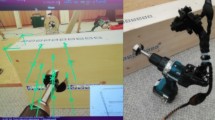Abstract
This paper proposes a wireframe model-based method for automated internal design. The method is used to extract geometric structure of an internal wireframe model and find out all loop structures of furniture models. The wireframe models are classified as the multiple independent sub-models according to the geometric structure by statistical analysis. The corresponding models are selected from a 3D model database to build an internal scene based on characteristic points of furniture wireframe models. In the experiments 3D database via manually selected 268 3D furniture models from Google 3D warehouse is built up. The experiments show that the method can construct 3D scenes in 1.1×103 ms. This method costs less time compared with traditional hierarchical method and depth-sensing camera method in the same experimental conditions. The method can be also used for 3D visualization either with complex backgrounds.
Similar content being viewed by others
References
Yoruk E, Vidal R. Efficient object localization and pose estimation with 3D wireframe models [C] // Computer Vision Workshops (ICCVW), 2013 IEEE International Conference. Piscataway: IEEE Press, 2013: 538–545.
Li X, Gao M T, Zhao J. Review on identifying faces of polyhedron wireframe models [J]. Journal of Graphics, 2014, 35(5): 663–668.
Hao R W, Sun Y H, Huang J L, et al. Class-based interior design CAD system’s development [J]. Journal of Image and Graphics, 2000, 5(6): 510–515.
Chen G M, Li G Q, Liu P, et al. Hierarchical constraints with particle swarm optimization for furniture arrangement [J]. Journal of Computer-Aided Design & Computer Graphics, 2014, 26(10): 1603–1612(Ch).
Shao T J, Xu W W, Zhou K, et al. An interactive approach to semantic modeling of indoor scenes with an RGBD camera [J]. ACM Transactions on Graphics, 2012, 31(6): 439–445.
Wen Y M. Studies on 3D Solid Reconstruction from 2D Engineering Drawings with Sectional Views [D]. Beijing: Tsinghua University, 2012(Ch).
Yan Q W, Chen L P, Tang Z. Efficient algorithm for the reconstruction of 3D objects from orthographic projections [J]. Cad Computer Aided Design, 1994, 26(9): 699–717.
Merrell P, Schkufza E, Li Z, et al. Interactive furniture layout using interior design guidelines [J]. ACM Transactions on Graphics, 2011, 30(4): 76–79.
Yang X G, Wang J. Collaborative application of computer technology in interior design [J]. Applied Mechanics & Materials, 2014, 651: 2067–2070.
Nan L L, Xie K, Sharf A. A search-classify approach for cluttered indoor scene understanding [J]. ACM Transactions on Graphics, 2012, 31(6): 137.
Author information
Authors and Affiliations
Corresponding author
Additional information
Foundation item: Suppported by the National Natural Science Foundation of China (61303214)
Biography: XU Xiaosheng, male, Master candidate, research direction: computer graphics.
Rights and permissions
About this article
Cite this article
Xu, X., Jin, P. & Zhang, L. A wireframe model-based method for automated internal design. Wuhan Univ. J. Nat. Sci. 21, 319–323 (2016). https://doi.org/10.1007/s11859-016-1176-3
Received:
Published:
Issue Date:
DOI: https://doi.org/10.1007/s11859-016-1176-3




